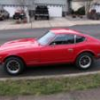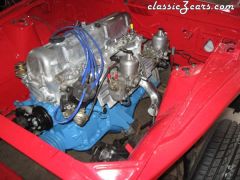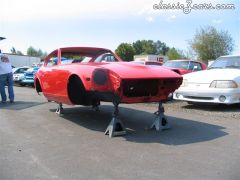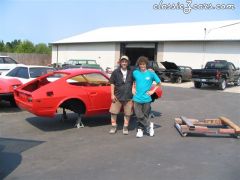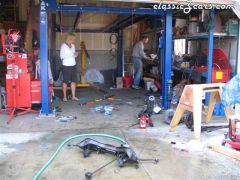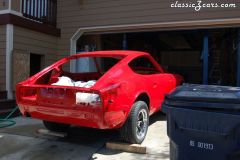Excuse me if your not a motorhead, but I thought those of you who are might be intereseted in the following. Its often been repeated that if you dont have enough backpressure the torque output of your engine will suffer. I have even repeated this statement. However I have never heard any proof of this "fact". I read an exhaust system comparison in one of the automotive magazines where they dyno tested on a V8 engine, back to back 2.5,3.0 and 3.5" exhaust systems. Torque and horsepower increased with each increase in exhaust system diameter. A quick google search revealed this article. Which I thought was quite revealing, and dispels some commonly held myths about exhaust system backpressure. "xhaust backpressure the myth -------------------------------------------------------------------------------- Backpressure: The myth and why it's wrong. I. Introduction One of the most misunderstood concepts in exhaust theory is backpressure. People love to talk about backpressure on message boards with no real understanding of what it is and what it's consequences are. I'm sure many of you have heard or read the phrase "Engines need backpressure" when discussing exhaust upgrades. That phrase is in fact completely inaccurate and a wholly misguided notion. II. Some basic exhaust theory Your exhaust system is designed to evacuate gases from the combustion chamber quickly and efficently. Exhaust gases are not produced in a smooth stream; exhaust gases originate in pulses. A 4 cylinder motor will have 4 distinct pulses per complete engine cycle, a 6 cylinder has 6 pules and so on. The more pulses that are produced, the more continuous the exhaust flow. Backpressure can be loosely defined as the resistance to positive flow - in this case, the resistance to positive flow of the exhaust stream. III. Backpressure and velocity Some people operate under the misguided notion that wider pipes are more effective at clearing the combustion chamber than narrower pipes. It's not hard to see how this misconception is appealing - wider pipes have the capability to flow more than narrower pipes. So if they have the ability to flow more, why isn't "wider is better" a good rule of thumb for exhaust upgrading? In a word - VELOCITY. I'm sure that all of you have at one time used a garden hose w/o a spray nozzle on it. If you let the water just run unrestricted out of the house it flows at a rather slow rate. However, if you take your finger and cover part of the opening, the water will flow out at a much much faster rate. The astute exhaust designer knows that you must balance flow capacity with velocity. You want the exhaust gases to exit the chamber and speed along at the highest velocity possible - you want a FAST exhaust stream. If you have two exhaust pulses of equal volume, one in a 2" pipe and one in a 3" pipe, the pulse in the 2" pipe will be traveling considerably FASTER than the pulse in the 3" pipe. While it is true that the narrower the pipe, the higher the velocity of the exiting gases, you want make sure the pipe is wide enough so that there is as little backpressure as possible while maintaining suitable exhaust gas velocity. Backpressure in it's most extreme form can lead to reversion of the exhaust stream - that is to say the exhaust flows backwards, which is not good. The trick is to have a pipe that that is as narrow as possible while having as close to zero backpressure as possible at the RPM range you want your power band to be located at. Exhaust pipe diameters are best suited to a particular RPM range. A smaller pipe diameter will produce higher exhaust velocities at a lower RPM but create unacceptably high amounts of backpressure at high rpm. Thus if your powerband is located 2-3000 RPM you'd want a narrower pipe than if your powerband is located at 8-9000RPM. Many engineers try to work around the RPM specific nature of pipe diameters by using setups that are capable of creating a similar effect as a change in pipe diameter on the fly. The most advanced is Ferrari's which consists of two exhaust paths after the header - at low RPM only one path is open to maintain exhaust velocity, but as RPM climbs and exhaust volume increases, the second path is opened to curb backpressure - since there is greater exhaust volume there is no loss in flow velocity. BMW and Nissan use a simpler and less effective method - there is a single exhaust path to the muffler; the muffler has two paths; one path is closed at low RPM but both are open at high RPM. IV. So how did this myth come to be? I often wonder how the myth "Engines need backpressure" came to be. Mostly I believe it is a misunderstanding of what is going on with the exhaust stream as pipe diameters change. For instance, someone with a civic decides he's going to uprade his exhaust with a 3" diameter piping. Once it's installed the owner notices that he seems to have lost a good bit of power throughout the powerband. He makes the connections in the following manner: "My wider exhaust eliminated all backpressure but I lost power, therefore the motor must need some backpressure in order to make power." What he did not realize is that he killed off all his flow velocity by using such a ridiculously wide pipe. It would have been possible for him to achieve close to zero backpressure with a much narrower pipe - in that way he would not have lost all his flow velocity. V. So why is exhaust velocity so important? The faster an exhaust pulse moves, the better it can scavenge out all of the spent gasses during valve overlap. The guiding principles of exhaust pulse scavenging are a bit beyond the scope of this doc but the general idea is a fast moving pulse creates a low pressure area behind it. This low pressure area acts as a vacuum and draws along the air behind it. A similar example would be a vehicle traveling at a high rate of speed on a dusty road. There is a low pressure area immediately behind the moving vehicle - dust particles get sucked into this low pressure area causing it to collect on the back of the vehicle. This effect is most noticeable on vans and hatchbacks which tend to create large trailing low pressure areas - giving rise to the numerous "wash me please" messages written in the thickly collected dust on the rear door(s)." __________________ Steve Frisby 1971 Datsun 240z-under restoration(wifes car) 2004 Nissan 350z (wife thinks its her car) 1971 455 Stage 2 skylark custom




